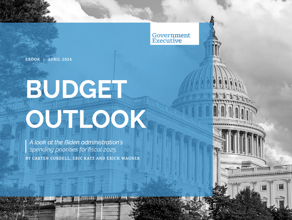Heads in the Cloud
A floating workforce on demand, much like Web-based computing services, could revolutionize the way government works.
For young Tyler Robinson, it was a dream job. The opportunity to change government and improve the way it works were what lured him cross-country from his private sector position in Oregon to a federal job in Washington in the Presidential Management Fellows program.
Robinson is on the executive board of Young Government Leaders, a grass-roots organization that educates and develops the next crop of federal executives. He and his 20-something colleagues chose careers in government because of its strong missions and challenging work. But they often find themselves operating in a workforce structure designed in the 1950s mostly for clerks.
At the dawn of the General Schedule pay system, 62 percent of the workforce fell within Grades 1 through 5 while only 11 percent were in the top five grades. By 2011, those numbers had reversed, with 8 percent of workers in the bottom five grades and 44 percent in the top five. The predictability and complexity of federal work has changed drastically, but the hierarchical personnel system has not.
So what if government were to transform the way it manages and organizes its workforce? Budgets are tight, and agencies simply can’t go on hiring sprees when workloads spike. Nor can they afford to carry excess staff when their services aren’t needed. Imagine a world where managers could place workers with specialized skills where they need them, when they need them. Perhaps agencies could learn a few lessons from a game-changing concept of on-demand services in the technology world: the cloud.
Cloud computing is revolutionizing federal operations through shared services, cost savings and virtualization, and government could apply these same principles to the workforce to improve flexibility and efficiency, says Dan Helfrich, a principal at professional services firm Deloitte. GovLab, a think tank in the company’s federal practice, is developing a concept it calls Fed Cloud.
In the cloud, specialized employees would no longer work for a single agency but rather the government at large. “Knowledge-based workers with aggregated skills and insights would be called up for a defined period of time to solve a problem,” Helfrich says. “Then we’d find the next best thing for that person in his or her skill set to go solve.”
The idea is to make agencies thinner and more mission-focused, with fewer workers supporting ongoing operations and to maintain a corps of professionals in the cloud focusing on specific projects or universal services. According to
Helfrich, traditional office functions like human resources, finance and information technology would move to a shared services model, making virtual work more prominent and reducing the need for office space.
GovLab estimates 15 percent to 30 percent of federal jobs could move to the cloud, including program managers, economists, performance experts and public health specialists. Face-to-face jobs like agency directors, inspectors, corrections officers and passport office workers would remain in their agencies, Helfrich says. “As we get a new wave and new generation of employees over the next decade, there’s a big opportunity,” he says. “Fed Cloud represents a way to manage knowledge and tackle government problems more effectively and with potentially fewer people.”
Net Generation
Restructuring in the cloud could allow agencies to take advantage of the talents and work styles of 20-somethings like Robinson, who are just entering the workforce. Collaboration, shared responsibility and consensus reign supreme in the millennial’s ideal workplace, according to a 2010 survey by market research consulting firm Intrepid, now Alterian Insights, and Mr. Youth, a marketing agency.
That’s exactly the type of environment that a workforce cloud implies, Helfrich says. Over the course of their careers, employees would have more breadth of experience, having worked with many more people, departments and agencies on a broader set of challenges. Advanced communications and mobile technology give workers the flexibility, responsibility and collaboration opportunities necessary to drive motivation without having to set foot in a federal building, he adds.
The State Department has launched a program that builds on the strengths and skills of Generation Y, born between 1980 and 2000. Last fall, the department’s Virtual Student Foreign Service program, which offers online internships, launched a microtasking pilot to farm out unclassified projects to student volunteers.
Using a program called Sparked—a collaboration platform developed by The Extraordinaries Inc., a San Francisco-based firm that facilitates online communities—State Department workers can post projects that require anywhere from 20 minutes to a couple of hours to complete. As part of the pilot, State invited 1,400 college students who applied to its eInternship program last summer to be beta testers for the site, says Bridget Roddy, program manager for the Virtual Student Foreign Service. Student tasks range from creating a welcome brochure on life in Guyana to designing simple data charts for presentations.
“We offer virtual internships to college students, but because there was such a high demand for opportunities to engage with the State Department, we thought about how else we could engage college students to help us with the work we do,” she says. The State Department plans to launch a full-scale version of its microvolunteering platform in the next few months, opening it up to all American college students.
If the initiative is successful, Roddy says the hope is to incorporate microtasking among State employees. “We have such a diverse workforce,” she says. “By allowing employees to devote 5 percent of their workweek to other projects, they will feel empowered and develop skills they might not have always been able to develop in their current position.”
The program is sparking interest from other agencies as well. The General Services Administration has called the State Department to discuss microtasking and whether it would be appropriate for GSA and the federal government as a whole. “The question is, how can we apply this sort of model to how we work, whether it’s working with external audiences or with internal employees,” Roddy says.
Culture Shift
Changing work processes through online tools is not without its challenges. “Anytime you introduce a new technology, especially into a government organization, it takes time,” Roddy says. “There definitely is a culture shift. We have to show how the technology is valuable, how people can use it to change the culture and make people comfortable using the technology.”
Adopting a workforce cloud across government would undoubtedly require an even bigger leap of faith for employees.
Despite advances in technology, some skeptics question whether the concept could ever be possible. The Office of Personnel Management, for example, recently put an end to its Results Only Work Environment—which gave 400 OPM employees the freedom to decide where and when they work—after it failed to produce results. “I don’t fully know why ROWE wasn’t more embraced or more successful,” says John Palguta, vice president for policy at the nonprofit Partnership for Public Service. “My suspicion is that it was more of a culture change than some were ready for.”
Still, Palguta argues that jobs in the cloud could take hold, considering the rate of telework adoption. Since the passage of the 2010 Telework Enhancement Act, agencies have sharply increased the number of participants. “Telework was slow to start, but now it’s an accepted workplace flexibility,” he says.
The challenges are not limited to changing work habits, however. Perhaps more important, it’s about reconfiguring the personnel system, Helfrich says, noting the workforce structure and General Schedule pay system have not been updated to account for more creative, collaborative and complex work. “Change certainly isn’t easy,” he says, “but a more merit-based system that rewards . . .
collaboration and performance is absolutely the direction the government needs to go, and I believe the direction that the vast majority of federal executives, supervisors and workers ultimately seek.”
GovLab’s Fed Cloud model proposes an alternative to the GS system to determine pay and career advancement by taking some cues from online gamers. Cloud employees would be rated and paid by the accumulation of Experience Points, or XP, through effective performance on cloud projects, training, education and professional certifications. Career progression would steer away from time served in a pay grade and toward milestones that are meaningful for employee development. And just as XP could be gained through learning new skills, it also could be lost by failing to apply skills, having too much down time and poor performance.
Robinson of Young Government Leaders says the Experience Point model could appeal to entry-level professionals, many of whom are more interested in moving up the career ladder than they are in changes to federal pay. “If promotions are more flexible, that can drive a lot and provide the proper incentives,” he says.
While government has sought to overhaul its pay and performance system, some large-scale attempts, like the National Security Personnel System at the Defense Department, have failed. Even so, Helfrich argues the government should not limit its options. “Some of the philosophy and concepts of performance management reform and civil service reform have been embedded in certain attempts like NSPS, but the execution of those has struggled,” he says. “Execution of these things is tough because it’s political, historical and cultural.”
A Way Forward
Overhauling the federal org chart seems like a daunting task, but the power really is in the hands of managers, according to Palguta. “Figuring out the logistics—how work is assigned and how quality control is done—is a management issue that can be figured out,” he says.
So how do managers get there, then?
Helfrich says it can be done incrementally, using commercially available technology that many agencies already have licenses for. “It’s tough to say let’s implement this with a big-bang approach, get a huge investment in technology and get everyone in government to build it up,” he says. “It would collapse under its own weight. You need to start small, have success and then the return on investment builds the business case for the future.”
According to Helfrich, building a workforce in the cloud is becoming more plausible as older workers who tend to cling to cultural norms approach retirement. The cloud concept also could help agencies solve problems more efficiently and with fewer workers, he says. The Republican budget plan released by lawmakers in March includes a partial federal hiring freeze under which only one replacement would be hired for every three employees who leave.
At the same time, agencies could manage knowledge transfer from one generation to the next, Helfrich adds. The federal government is beginning to see an increase in retirements—up 24 percent in 2011. The question is how to leverage the talents of seasoned workers who are eligible to leave. “Some retiring workers may not want to quit altogether, and a flexible model could be an enticing way to keep their expertise on retainer,” a GovLab report says.
The most important ingredient for Fed Cloud is bold leadership, Helfrich says. But other ways to kick-start the concept, he notes, include building collaboration space for employees, both virtually and physically; creating a rotational program that allows staff members to work across departments and specialties; and starting a volunteer cloud like State’s that allows managers to seek help on projects.
Agencies could start with a pilot to test a people cloud in segments of their workforce, Helfrich says, allowing them to document lessons learned and determine the viability of the model on a wider scale.
“Within five years, we could have multiple departments and agencies that have deployed the Fed Cloud concept,” he says. “Armed with those success stories, we could construct the case for the kinds of structural reforms that we need to make it big and sustainable and find new ways to solve government problems. This is not a 50-year thing, and it’s not a three-year thing. It’s somewhere in the middle.”
Brittany Ballenstedt, a former staff writer for Government Executive, covers the IT workforce for Nextgov.
NEXT STORY: Hard Sell






